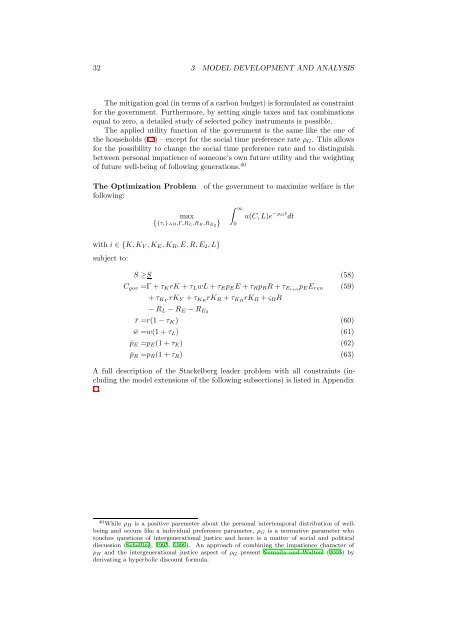Modeling Climate Policy Instruments in a Stackelberg Game with ...
Modeling Climate Policy Instruments in a Stackelberg Game with ...
Modeling Climate Policy Instruments in a Stackelberg Game with ...
You also want an ePaper? Increase the reach of your titles
YUMPU automatically turns print PDFs into web optimized ePapers that Google loves.
32 3 MODEL DEVELOPMENT AND ANALYSIS<br />
The mitigation goal (<strong>in</strong> terms of a carbon budget) is formulated as constra<strong>in</strong>t<br />
for the government. Furthermore, by sett<strong>in</strong>g s<strong>in</strong>gle taxes and tax comb<strong>in</strong>ations<br />
equal to zero, a detailed study of selected policy <strong>in</strong>struments is possible.<br />
The applied utility function of the government is the same like the one of<br />
the households (12) – except for the social time preference rate ρ G . This allows<br />
for the possibility to change the social time preference rate and to dist<strong>in</strong>guish<br />
between personal impatience of someone’s own future utility and the weight<strong>in</strong>g<br />
of future well-be<strong>in</strong>g of follow<strong>in</strong>g generations. 40<br />
The Optimization Problem of the government to maximize welfare is the<br />
follow<strong>in</strong>g:<br />
max<br />
{{τ i},ς R,Γ,R L,R E,R E2 }<br />
∫ ∞<br />
0<br />
u(C, L)e −ρGt dt<br />
<strong>with</strong> i ∈ {K, K Y , K E , K R , E, R, E 2 , L}<br />
subject to:<br />
S ≥S (58)<br />
C gov =Γ + τ K rK + τ L wL + τ E p E E + τ R p R R + τ Eren p E E ren (59)<br />
+ τ KY rK Y + τ KR rK R + τ KR rK R + ς R R<br />
− R L − R E − R E2<br />
¯r =r(1 − τ K ) (60)<br />
¯w =w(1 + τ L ) (61)<br />
¯p E =p E (1 + τ E ) (62)<br />
¯p R =p R (1 + τ R ) (63)<br />
A full description of the <strong>Stackelberg</strong> leader problem <strong>with</strong> all constra<strong>in</strong>ts (<strong>in</strong>clud<strong>in</strong>g<br />
the model extensions of the follow<strong>in</strong>g subsections) is listed <strong>in</strong> Appendix<br />
C.<br />
40 While ρ H is a positive paremeter about the personal <strong>in</strong>tertemporal distribution of wellbe<strong>in</strong>g<br />
and occurs like a <strong>in</strong>dividual preference parameter, ρ G is a normative parameter who<br />
touches questions of <strong>in</strong>tergenerational justice and hence is a matter of social and political<br />
discussion (Schell<strong>in</strong>g, 1995, 1999). An approach of comb<strong>in</strong><strong>in</strong>g the impatience character of<br />
ρ H and the <strong>in</strong>tergenerational justice aspect of ρ G present Sumaila and Walters (2005) by<br />
derivat<strong>in</strong>g a hyperbolic discount formula.
















